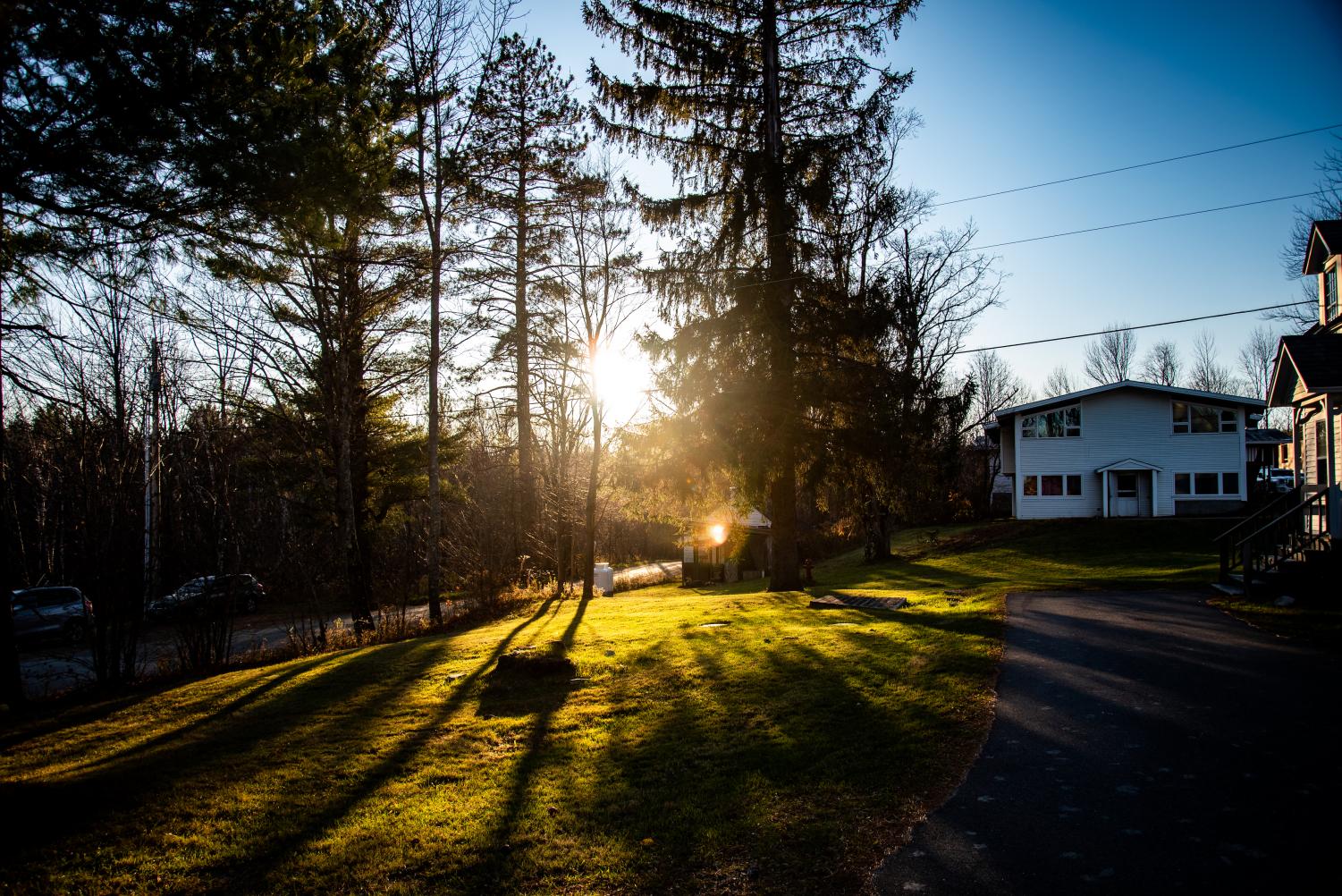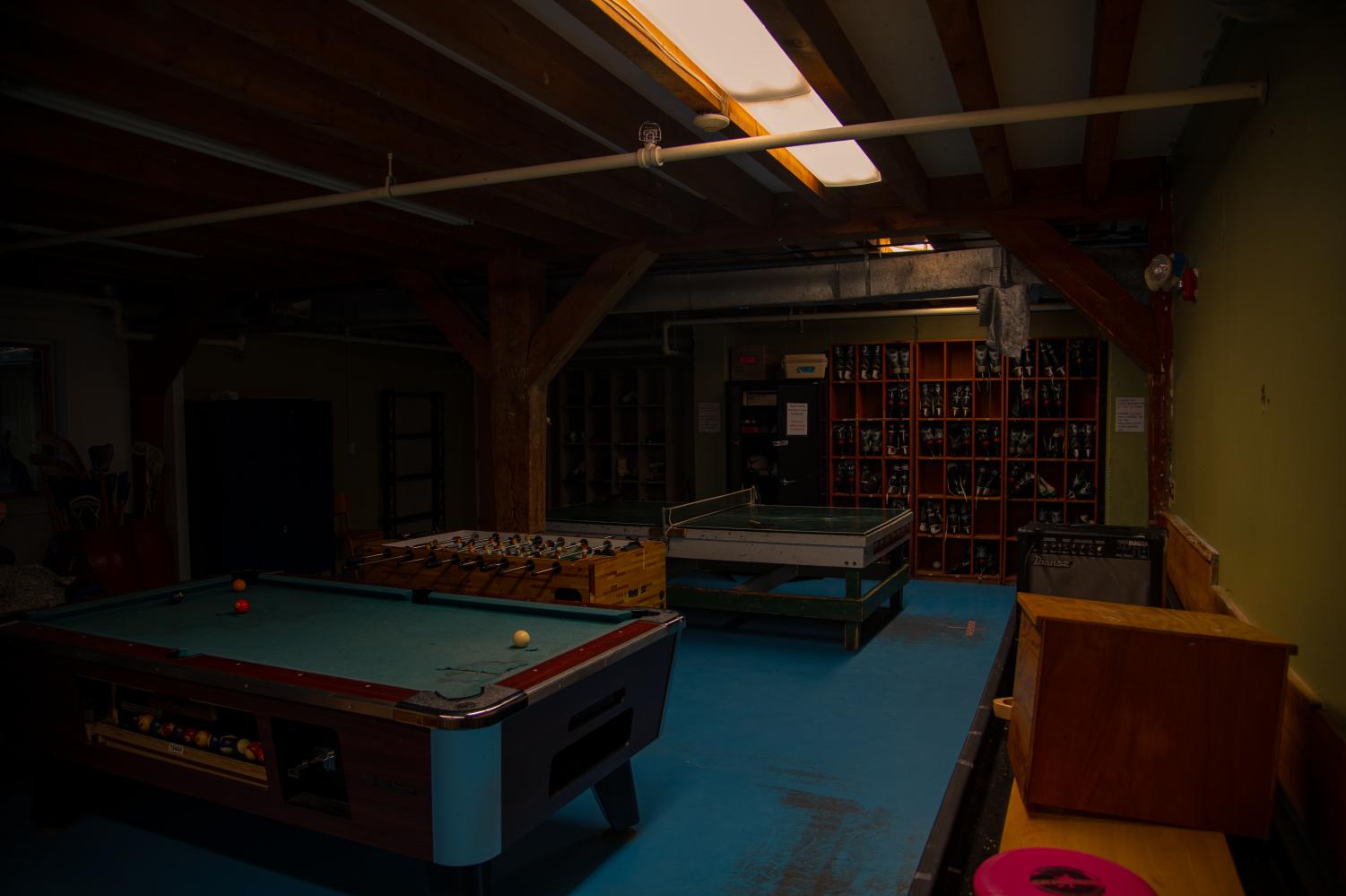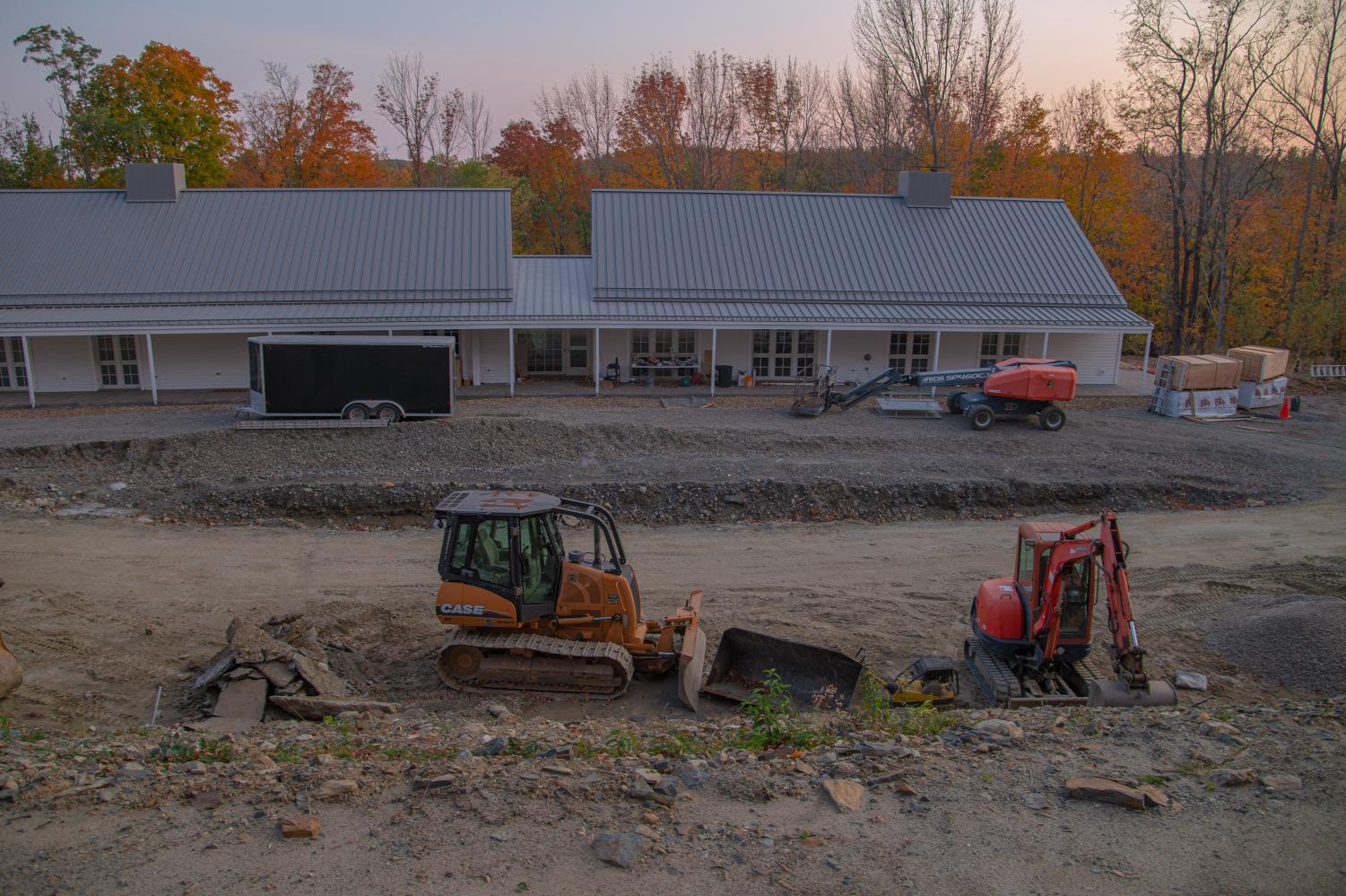In the fall, Potash Hill is silent. The smell of dying trees, turning leaves, and rotten apples on the forest floor wafts through the air. At the former site of Marlboro College, a serene and remote school often caked in snow at the top of a Southern Vermont mountain, there was usually a sense of peace. Of waiting. But this place is not what it once was. The place is not Marlboro, at least not anymore.
A year ago, the apples and brush were still there, paired with the smell of fresh peach cobbler cooking in the dining hall—a renovated cattle barn. But the air at Marlboro was thick with anticipation. Around 150 students gathered in the only auditorium on Nov. 6, awaiting an announcement from the college President Kevin Quigley.
Charlie Hickman, a junior at the time, was there.
“Throughout the whole meeting, I was really relaying the information the whole time,” Hickman said. “I felt like I was sitting in that room, like a stone statue.”
Hundreds of miles away that same day, Boston smelled of burnt rubber and gasoline. Of cigarettes and construction dust. Cars honked. The MBTA screeched. In the Cutler Majestic Theatre, the Emerson community also awaited an announcement from President M. Lee Pelton. Not with nervous anticipation, but with curious wonder.
Emerson would be acquiring Marlboro, its $30 million endowment, and funds from the sale of the campus, free of charge, at the end of the 2019-2020 school year. In exchange, the Boston college would accept Marlboro students at the tuition rate they already paid and offer faculty contracts to teach in the city. The “alliance” intended to flood an indebted Emerson with an influx of cash. Emerson’s crowd erupted with applause as Pelton announced the figures.
At Marlboro, there was one glaring detail in the Emerson deal that left students stunned: the college would be losing its beloved campus.
“There were people behind me sobbing,” Hickman said. “I was seeing my professors crying.”
When the dust settled, 57 students, 18 faculty members, and roughly $20 million in assets transferred from Marlboro to Emerson. That was after the community suffered through an early campus closure because of a global pandemic, a fight from alumni to stop the deal, and a controversial sale of the Potash Hill campus.
As The Beacon’s senior Marlboro reporter, I was tasked with covering the ins and outs of the merger. In total, I wrote nearly 40 stories on the beat. But in the end, Marlboro, a school I had fallen in love with, was inevitably closing. Covering this merger has been like riding a rollercoaster blindfolded. Nothing I experience will ever come close to the love Marlboro students felt for the place. Still, it pained me to watch this community that was so full of love, life, and a sincere emphasis on the liberal arts be stripped of everything it held dear.
In this story, I’m revisiting the logistics behind the Emerson-Marlboro merger and the people involved a full year after the initial announcement.
History of the hill

Walter Hendricks—a student of American poet Robert Frost—founded Marlboro College in 1946 after the end of the second World War. Hendricks wanted a place where students could have autonomy over the classes they took, instead of selecting one-size-fits-all style majors.
In the 1960s, students were required to work in the dining hall or for facilities. They received no credits nor pay. Instead, it was a part of their commitment to the campus.
“When I was there as a student….everyone had to work a certain number of hours a week,” said Dena Davis, one of 22 Marlboro Board of Trustee members. “There was more of that kind of DIY, we’re in this together feeling. I don’t know when that stopped…But I think it was a mistake.”
Like most small liberal arts colleges, Marlboro’s peak is in the rearview mirror. That’s clear in the numbers.
Since 2010, the college saw a 49 percent decline in total enrollment, according to data from the Department of Education. In 2017, Marlboro admitted 117 out of 121 applicants. But only 28 of them came. The next year, the admissions team was much more selective, with the hopes that admitting the right people would boost enrollment. They admitted 92 of 156 applicants, a 10-year low acceptance rate at 58 percent. Thirty-eight students came.
As Marlboro’s admissions dwindled, the average financial aid awarded to students increased every year, as did the number of students receiving financial aid. In the last three years of Marlboro’s existence, federal data showed that 100 percent of undergraduate students received some form of monetary help.
Hickman said the decline of Marlboro speaks to an ideological shift in America.
“I don’t know if there can be a viable place like Marlboro in the future, because of the economic system that we live in,” they said. “It does not value places like Marlboro against places like the Ivy Leagues.”
Fumio Sugihara, the former dean of admissions at Marlboro, said one of the other problems is the cost of higher education for the institution, rather than for the student. Colleges depend on grants and federal subsidization, as well as tuition deposits from wealthier families, to mitigate their operating costs. But that model is unsustainable.
At least six other New England colleges have shuttered since 2017. Four of those—Southern Vermont College, Green Mountain College, College of St. Joseph, and Newbury College—all closed in May 2019, all with eerily similar circumstances to Marlboro.
Before the Emerson merger was announced, Marlboro administrators leveled a deal with the University of Bridgeport. Under the terms of that agreement, drafted in summer 2019, Marlboro would still operate on Potash Hill as a satellite campus of Bridgeport, and students from either institution could attend classes at both campuses.
However, it became clear as time went on that Bridgeport was not as economically sound as it had claimed. Pulling out of the merger would prove to be a wise decision for Marlboro, as Bridgeport would be acquired by three separate colleges in the spring with a plan to teach-out its remaining students.
“What we found out…was that they weren’t in good faith,” Davis said. “And once we had turned over our endowment, which at that point was pretty close to $40 million, we would have had very little control over what happened next. We could not have stopped the sale at the campus.”
When Marlboro and Bridgeport ceased merger talks in Sept. 2019, the Vermont college initiated the search for another partner—and fast.
“There was a glorious month-ish between the Bridgeport merger falling through and the Emerson merger being announced that everyone, even me, lived in this blissful denial,” Hickman said. “It was easier to ride this wave…than to prepare for it to crash.”
Students on Potash Hill didn’t need to worry about what would come next.
“It was the fall again,” Hickman said. “We were having our apples from the apple trees on campus. My professor made a pie from the peaches that grew on the campus. It was so easy to lose myself in the beauty.”
A campus remembered

It’s hard to explain what made the Marlboro campus special.
The view, obviously, is impeccable, especially in the fall or the winter. Climbing to the crest of Potash Hill and winding through the backwood Vermont roads is a sight to behold. The first time I went to Marlboro, one week after the merger was announced, I couldn’t help but take pictures out of the car window. The leaves were starting to turn, as greens, reds, yellows, and oranges swarmed the ravine below the parking lot. It reminded me of a Monet painting. Maybe it was the cars in downtown Boston, but getting out of the car in Marlboro for the first time felt like walking into a soundproof room. It was eerily, yet calmly, silent.
The first time I interviewed Charlie Hickman was in a smoke shack, right across from the Marlboro dining hall. The tiny, wooden shack was littered with beer bottles on the bench seats and a broken, stripped guitar zip-tied to the roof. It felt cozy in the way a college basement feels cozy. I sat next to them, swapping my phone back and forth between my hands because of the cold.
Hickman served as Head Selectperson, which is essentially the Marlboro equivalent of Emerson’s Student Government Association President.
“I knew that the announcement was coming,” Hickman said. “I knew five days before the Selectboard was told, and Selectboard was told the day before the announcement…There were rumors going around that it was a place in upstate New York or Boston.”
Hickman pauses, obviously pulling at memories and feelings that are buried deep or painful to recollect.
“The way that I experienced it was very different than others,” they said pausing for nearly half a minute. “I felt so responsible for the well-being of my community, and of course, sitting in Whitmore Theater, I was devastated to hear what was happening. But I was like ‘Okay, Emerson College, not the worst.’”
Hickman said they still haven’t processed the loss of the Marlboro campus.

“I don’t think it’s going to be real for me until I graduate,” Hickman said, thinking about their graduation this spring. “We’re not going to be able to come back and visit Marlboro….I’m not going to be able to go to the dance studio whenever I want…no matter how much we are trying to adapt and grow into our place at Emerson, there is an irrevocable loss with the campus. And that cannot be transferred to a place in the middle of Boston.”
Students aren’t the only ones who wax poetic about Potash Hill.
Davis, a 1972 alum, said she misses her time on the Marlboro campus. Davis met her partner at Marlboro in the 60’s and has served on its Board for almost a decade.
“I grew up there like a lot of people,” she said. “I met the love of my life there. I was just thinking the other day about how I learned at Marlboro that I’m really good at math. I thought I was miserable at math….obviously, that’s in the past, no matter what happened. But, you know, the closed door on that is hard to accept.”
Her colleagues feel the same way, she said.
“This isn’t the kind of board where you get to meet influential people or something,” Davis said, tearing up. “So obviously, only your love for this institution would make you do this. And it follows therefore, that the death of this institution on your watch must be…I mean, it was worse than my divorce in terms of gut wrenching, and it still is.”
Sugihara said he did everything he could to keep Marlboro open.
“We use the word ‘believer’ [at Marlboro], and I still very much have that quality,” Sugihara said. “It’s a little tempered, it’s a little beaten up…My dream would have been able to keep Marlboro open. I would have given anything. I would have scratched lottery tickets.”
Sugihara was the first person I met at Marlboro. The car full of reporters I was with had no idea where to go or what to do when we first got to Marlboro, so we thought admissions would be a good place to start. The small admission lobby was not meant to house five reporters, our backpacks, and our gear. Our peacoats and lack of weather-appropriate attire made us stick out like a sore thumb.
“You must be The Berkeley Beacon!” a voice said, from an office I could not see.
Sugihara came out of his office and immediately set us at ease. He always made sure we were fed, insisting we eat the dining hall food before we drove back to Emerson, which was a blessing on the countless 12-hour days we spent on campus.
That dining hall was a sacred space for some Marlboro students.
“It’s very much a community space,” said Felix Bieneman, a senior at Emerson who came from Marlboro. “Especially this time of year, in the dining hall the lights would be on. There’d be people in there and…there’s always somebody you could talk to.”
Marlboro’s campus was loved by the wider community as well.
Jesse Kreitzer, a town resident and Emerson alum, said growing up near the Marlboro campus made an impression on him as a kid.
“I have a sort of nostalgia with a campus growing up here using the trails or some of its facilities,” he said.
I still remember the last reporting trip I made to that campus. When the other reporters and I left Boston, it was maybe 40 degrees, but there was no snow on the ground. By the time we got to Marlboro, the walkways looked like bowling lanes, bumpers of snow keeping the occupants on the designated paths.
No one knew what was coming.
On March 11, Marlboro administrators announced that they would elongate two-week spring break because of a new threat: COVID-19. By the 13th, the school had closed its dorms, and college officials were asking students to move their belongings off of campus quickly.
“[We were hoping] to have a semester that we were all going to have together to be able to commiserate with one another, and now we’re going to be scattered across the country—that is heartbreaking,” Hickman said in March.
Felix Bieneman left before the announcement. They were originally going to apply to stay in the dorms for Marlboro’s spring break but changed their plans because of the uncertainty from the virus.
“It was impulsive, like I packed everything I knew that I didn’t want to lose,” they said. “It was really surreal. I stopped to take some pictures. And [Quigley] waved outside his window, like his office window.” they said. “I was hanging out taking pictures and I was really emotional, too. I was not ready to be waved at out the window.”
Bieneman said they didn’t really feel the gravity of the closure until they started driving down the hill.
“I was like ‘Man, I am driving away,’ I’m just never gonna come back,” they said. “But it was like I just had to drive…It was extremely surreal.”
Hickman said while it was painful, they’re glad they have some final memories on campus. They organized a last minute dance performance as a final community event.
“I will savor this memory because Serkin dance studio is such an important place to me, but I remember we were starting the show, and we had to put seats around that were all six feet apart,” they said. “And there were all these questions of like, ‘Should we even have an audience?’ And the tears were flying, and looking around this room at people’s faces who I have not seen since then. Then after that performance that was it. That was the last tangible, Marlboro thing to happen in its intended form on campus.”
While Marlboro closed its doors sooner than expected, the merger itself was far from over. Soon, new faces would emerge as key—and controversial—players in the process.
A contentious path forward

When Marlboro sent over the Asset Transfer Agreement—a document that detailed the funds, and assets that would transfer and when—the Vermont Attorney General postponed a review until the campus sale contract was approved.
Davis said President Pelton’s stance on the campus was evident.“He was real clear that the campus was a white elephant, and it had to go if we were going to conclude this deal,” she said.
In April, Marlboro hired the Boston-based real-estate firm Colliers International to help market and sell the campus. But Davis said Marlboro didn’t necessarily want to find the highest bidder—just the right fit.
“We were not interested in just getting every last penny,” she said. “We were interested in finding a buyer who would be good for the town, a good landlord for the [annual Marlboro] music festival, and so on.”
According to Davis, the realtor presented the Board with four bids. One was from the Music Festival, which has a 99-year lease on the campus and also loaned Marlboro $1.5 million for new buildings. Another was from an entirely unknown entity: Democracy Builders.
Democracy Builders is the brainchild of Seth Andrew, who has more than 15 years of charter school experience and served in the Obama administration as senior advisor in the Office of Educational Technology. His nonprofit partners with several education nonprofits and charter schools, namely Democracy Prep, which currently has 21 schools nationwide.
Democracy Builders’ bid included a new venture for the group: Degrees of Freedom. The program for late high school and early college students aims to flip the traditional higher education model on its head by offering five concentrations—Finance, Technology, Education, Health and Justice—over two years.
The Board eventually picked Democracy Builders and its Degrees of Freedom program in May after a six-month search process. The organization paid $225,000—just 2.25 percent of the $10 million estimate—for the 600-acre campus.
Davis said she voted for the program in part for the diversity it promised to bring the town.
“Selling [to] Democracy Builders, my understanding is most of the people running that, except for Seth Andrew, are people of color,” she said. “And they’re living there with their families and sending their kids to the local school.”
Marlboro President Kevin Quigley said that the college picked Democracy Builders to maintain the ethos of Marlboro on the campus.
“We recognize that all of us would prefer that Marlboro College remain as is on our beautiful campus in the foothills of the Green Mountains,” he said in a May statement. “We are, however, very fortunate to have found a path that both continues our distinctive liberal arts mission at Emerson and offers an opportunity for something new to take root here on the Hill that will be respectful of our heritage.”
Soon after the announcement was made, however, students and faculty from Democracy Prep, which Andrew founded in 2005, spoke up. This whole deal took place against the backdrop of yet another racial reckoning in America. A national conversation is happening—spurred by protests after the death of George Floyd—about the treatment of people of color within corporations, news organizations, and schools. Former Democracy Prep students and teachers started to speak publicly about abuse and neglect they experienced in the schools.
A group named “Black N Brown at DP” released anonymous testimony on social media, detailing hundreds of allegations of systemic abuse and neglect against Andrew and Democracy Prep. The allegations gained widespread attention in the town, which held a town meeting in late July on the matter.
A statement on the Marlboro website in July said the Marlboro Board of Trustees was doing everything to “encourage a positive and constructive learning environment for all students who come to Degrees of Freedom” and acknowledged the “regret and anguish the campus sale…has caused.”
Students at Marlboro, while they were not on campus, were still tuned in to the happenings of the sale. Hickman said that, at the outset, they were excited that Marlboro was being sold to a school.
“I was glad that it was still going to be an educational institution,” they said. “Of course, I was not jazzed about the campus being sold to a charter school. And of course, I was even less glad when I heard about the racist history of Seth Andrew and his institutions. But I knew that the campus being sold was one of the things holding up the deal from being finalized.”
Then Marlboro students were left in limbo. While the semester was done and the merger deal was signed, Marlboro students could not enroll in Emerson courses or plan their education until the details were complete.
Two months after, the Vermont Attorney General T. J. Donovan approved the deal. Now Democracy Builders is operating on campus with a small chunk of students, according to Chandell Stone, chief growth officer at Democracy Builders.
“We are developing a program that meets the needs of historically marginalized communities,” she wrote in a statement. “All of our design work is being done in collaboration with our 20 Freedom Builder Fellows, who are amazing young adults from all across the country united under the vision of making higher education more accessible for all students.”
Stone said the first Degrees of Freedom class is anticipated to be on the campus next fall, with around 300 students coming to the campus three times per year for two week periods.
The view from Boylston

Emerson administrators named the Institute for Liberal Arts and Interdisciplinary Studies, the college’s home for liberal arts classes, after Marlboro. There, 18 former Marlboro faculty now teach alongside Emerson faculty.
While Marlboro itself is no more, Emerson has attempted to give Marlboro students a voice at the college. Several working groups that aided the merger still meet regularly, and there is a Marlboro Representative in SGA. However, Marlboro students must remain within the Individually Designed Interdisciplinary Program if they wish to keep their tuition discount, and they cannot study away at any of Emerson’s programs, including Emerson Los Angeles and Kasteel Well.
“We wholeheartedly welcome Marlboro students and faculty and the launching of the Interdisciplinary Studies major within the newly named Marlboro Institute,” Dean of Liberal Arts Amy Ansell wrote in an email announcing the completion of the deal. “In this way, we honor and preserve the legacy of Marlboro’s distinctive approach to undergraduate education.”
It’s unclear how the Marlboro Institute will incorporate Marlboro’s curriculum in the future, but Charlie Hickman is fighting to keep the college’s spirit alive at Emerson.
“I hope that the Marlboro Institute is given a standing space on campus, that they can have some governmental control over, that there can be space for democratic decision making and flexibility within the curriculum,” they said. “Both Emerson and Marlboro are stretching to create this new thing. But it will never be what we had. And that’s a shame, but it’s an inevitable shame.”
At the end of the merger, everything seemed to stop. Towards the end of the deal, news was happening at such a rapid pace. It felt like being on Boylston Street, swerving between passerby and growing deaf from the car horns. But, at the end, it felt like standing on top of Potash Hill. Eerily quiet, and deafening in a completely different way.
There will never be another Marlboro College. While Emerson can do its best to incorporate its essence into the Marlboro Institute, it will always be a skeleton of what Marlboro was—though there’s no shortage of efforts from President Pelton and upper administration to prove otherwise.
“Marlboro‘s legacy will live on, their students will benefit from enhanced educational programs, and their tenured and tenure-track faculty will continue to teach in an environment that supports intellectual creativity, innovation, and experiential learning,” Pelton said in November.
Marlboro was not special just because of its education. It was special because of its people, its history, its system, and its campus. A school like Marlboro can only exist in the isolated foothills of the Green Mountains, yet the likelihood that other schools like it will survive is slim. Harvard Business School professor Clay Christensen predicts half of all colleges and universities will be bankrupt in the next 10 to 15 years. Marlboro should not be remembered as another statistic or another college that closed its doors. It should be upheld as a model for a better education and a place that aimed to shape a better world.
“I realized, during my time at Marlboro, that I am more than the world I grew up in,” Hickman said at the end of our interview. “I cannot imagine another place where I would want to go to school.”